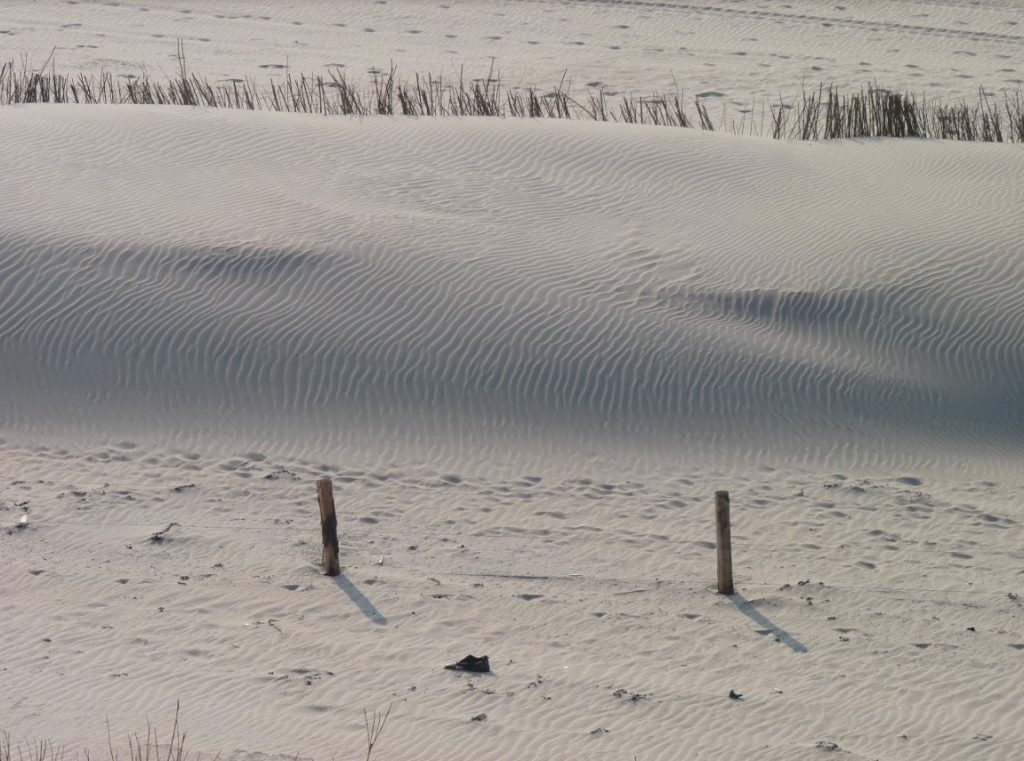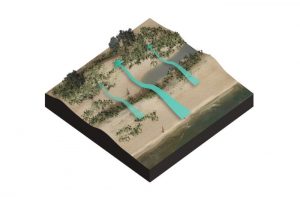How to use
The concept ‘Enhancing dune dynamics’ implies the stimulation of natural (dynamic) processes of dune development and succession. We distinguish two types that occur in coastal areas:
- 1) a situation of existing coastal dunes that have lost (part of) their natural dynamics, and
- 2) a situation where at present no coastal dune system exists, and where ‘new’ coastal dunes are designed. We call this ‘dune reconstruction’.
In this ‘How to use’-section, both of these types are described and explained as well as the monitoring and maintenance questions that need to be answered for both these types.
When designing a dune landscape or enhancing dune dynamics in an existing dune environment, one needs to define one or more objectives. This could be flood safety, ecology and/or recreation (often a combination). As a dune system is multifunctional, the design process should include a multi-stakeholder approach. The dune landscape will change over time. If flood safety is one of the functions of the dune landscape, investigate the erosion rate of the system to determine the expected strength of the created dune landscape over time. Define with all stakeholders, such as nearby villagers, nature conservationist and small businesses, what desired and acceptable dune dynamics are, in other words: to what extend will you let the dunes behave naturally and where is management needed. For more information, read also the enablers on multi-stakeholder approach and management, maintenance and monitoring.
Enhancing dune dynamics in existing coastal dunes
Enhancing dune dynamics in existing coastal dune systems often aims at enabling more sand to be transported within and into the dune area. In a stabilized environment it is unlikely this will occur naturally (Schwarz et al, 2018). In areas where the dune system is more stabilized and has become inactive, there are several strategies to locally enhance dune dynamics (Arens et al., 2013; Dynamisch kustbeheer (in Dutch)). Here, we distinguish strategies in the different zones as described before: beach and incipient foredune, the foredune and the hinterdunes.
Enhancing dynamics in beach and incipient foredune
Strategies to enhance dune dynamics in the beach and incipient foredune are strategies that stimulate and enable embryo dunes to develop. Embryo dunes are found to develop in areas with wide beaches (Puijenbroek et al., 2017). Examples of strategies to stimulate the development of embryo dunes are:
- Leave flood marks on the beach. These can be the basis for pioneer vegetation (embryonal dunes) and are a source of food for several animals and birds.
- Prevent driving cars on the beach as this can hamper the formation of starting dunes.
- Removal of obstacles at the dune foot such as beach houses or pavilions to let sand blow from the beach into the dunes.
Embryo dunes are by itself dynamic. However, it has to be considered that when promoting the growth of embryo dunes, dynamics in the foredune and backdunes might decline: With the sand being trapped by the embryo dunes, less sand will be transported to the foredune and hinterdunes and this might lead to a reduction of dynamics there.
Enhancing dynamics in foredune
Strategies to enhance dune dynamics in the foredune usually include the removal of foredune vegetation, so sand can be uplifted and transported. Another strategy is the removal of other sand trapping objects (part of traditional dune management) such as brush wood fences (Figure 1). Then sand will no longer be trapped but can be blown further into the dune system.

By removing vegetation, the available sand in the system gets more opportunity to be transported to the hinterdunes. This can for example be done by creating blowouts in the foredune that locally destabilize the dune system. Foredune blowouts are erosional features that allow aeolian flow-through of siliciclastic sand from the beach into the hinterdunes. As such, foredune blowouts contribute to dynamic, resilient, and species-rich coastal habitats (Schwarz et al., 2018). These blowouts might grow into notches but might also become (again) more stabilized when pioneer species settle and a process of recolonization of the blowout starts. Pilots have shown that it is possible to increase the mobility of sand in the foredune system locally by either manually creating foredune notches/blowouts or allowing natural blowout formation by discontinuing stabilization measures (Schwarz et al, 2018). In the long run removing (some) of the vegetation in certain areas actually increases flood safety, because sand will be transported further landward and higher in the dunes which makes it more resilient to, for example, sea level rise.
A common misunderstanding is that blowouts and notches are regularly flooded by water from the sea. This is not the case. The entry height of most blowouts and notches is high because they are formed by wind, which makes it even during an extreme storm a dry area. Features that are more regularly flooded are called washovers and tidal inlets. Washovers and tidal inlets are the morphological features along a dynamic coast which are formed by hydrodynamic processes and have a relatively low entry height. These can form when a breach in the first dune occurred during a storm event.
Enhancing dynamics in hinterdunes
Strategies to enhance dune dynamics in hinterdunes also comprise of removal of coastal vegetation. Here, dune dynamics can be enhanced by excavation former blowouts to reactivate them. Active grazing, to create patches of bare land can also be an effective strategy if it is correctly applied. Special attention should be given to remove invasive plant species because these tend to proliferate quickly.
In the Netherlands, the goal of enhancing dune dynamics is to:
- restore protected dune habitats (ecosystems),
- improve recreational value and
- enable the dune system to keep up with sea level rise (Dynamisch kustbeheer, 2020).
A requirement is that the flood safety is not affected. This means that in some locations enhancing dune dynamics might not be possible because the existing dune system is not wide or strong enough to allow for an opening in the foredune. On locations where this is the case, creating notches in the foredune are not recommended. On these locations enhancing dune dynamics in the incipient foredune (by stimulation growth of embryo dunes) or in the hinterdune (e.g. excavation of blowouts) might still be possible.
Coastal dune reconstruction
In coastal dune reconstruction, ‘new’ coastal dunes are designed and developed. Starting point in this concept is that ‘new’ coastal dunes are created on a location where there used to be a dune system in the past. A dune landscape will only succeed when it existed in that location in the past, and where the present processes can sustain the restored dune system. Dunes can disappear due to a variety of reasons. This can be caused by natural events such as storms, sea level rise and/or overwash. Dunes may also disappear because of human interference. To decide on the feasibility of a ‘new’ coastal dune system, research should identify the cause(s) of the historic dune system disappearance of that specific case.
The reconstruction of a coastal dune system implies a large amount of sand of multiple tens of millions of cubic meters, dependent on the size of the coastal dune area and foreshore that is created. The main difference with a ‘feeder beach’ is that this sand is already (partly) shaped into a dune and beach profile.
In case of coastal dune reconstruction it is important that sand is being used with the right grain size and chemical characteristics (e.g. origin, calcium levels) to allow for sand drift and to provide the circumstances for the original flora and fauna to develop. However, the ecological development also depends on other factors such as seed sources. Because in new coastal dunes the vegetation has not developed yet, the abiotic physical processes are dominant and initial aeolian sand transport can be high. Therefore, measures in these dune systems sometimes are taken to initially reduce dune dynamics instead of stimulating them.
When reconstructing dunes, dune systems can be designed taking into account ambitions with respect to envisioned dune system. Local measures enhance or inhibit dune dynamics at specific locations. For instance, planting vegetation or placing brushwood fences along a cycle path to diminish nuisance from blowing sand. In addition, designs on a higher scale level can include variability of areas where vegetation is planted and areas were no vegetation is planted creating differences in topography for recreational purposes, et cetera.
Barren dunes are susceptible to deflation by wind, with landward migration taking place. However, natural colonization by pioneer species can occur on the beach and the front dune which results in stabilization. These are species that are adapted to retain drifting sand. In case of dune reconstruction it might be necessary to stimulate vegetation growth by initially planting indigenous species that are characteristic for dune colonization (builder sand plants such as Ammophila arenaria, or Elymus fractus because they enable sand stabilization). An overview of sand binding plants that are adapted to saline, nutrient-poor and harsh hydro-sedimentary conditions in different areas in the world can be found in an article on shore protecting vegetation (Shore protecting vegetation).
In most cases when dunes are restored, a large amount of sand needs to be nourished in the area (at the Hondsbossche Dunes with an alongshore length of several km, 35 Mm3 of sand was used to construct both foreshore, beach and dune area). To enhance the growth of dunes brushwood screens could be used to trap sand more effectively (NB: Use indigenous species, as seedlings from the screens may be transported into the dune system). However, depending on local possibilities and desired functions, the stabilization measures should not be so comprehensive that they completely fixate the dunes. One strategy to allow for some dune dynamics and let sand drift is to leave some areas without vegetation in order to create some locations were blowouts can form.
Monitoring and maintenance
By definition, dunes change over time. Monitoring is necessary to assess whether the dune system develops in such a way that it meets the set objectives. The objectives that were set determine the monitoring indicators. Measures should be considered if these are not met (adaptive management). A monitoring program could be designed based on the following questions ( from Dynamisch Kustbeheer):
- Does the volume of sand change in the dune system over time (beach, foredune, backdune)?
- Is a profile change visible: do blowouts and/or notches appear and if so where and how deep are they?
- To what extend does the dune system erode with a heavy storm or several storms?
- Does an eroded dune recover itself due to natural aeolian (wind) transport of sand?
- How much sand blows over the dune area?
- What are the effects of the more dynamic dune area on other functions of the coast (recreation/ecology)?
- Can a blowout if necessary be stopped? Are we in control?
- Is adjustment of the coastal management desirable?
See also the enabler monitoring and maintenance for more information on this topic.

